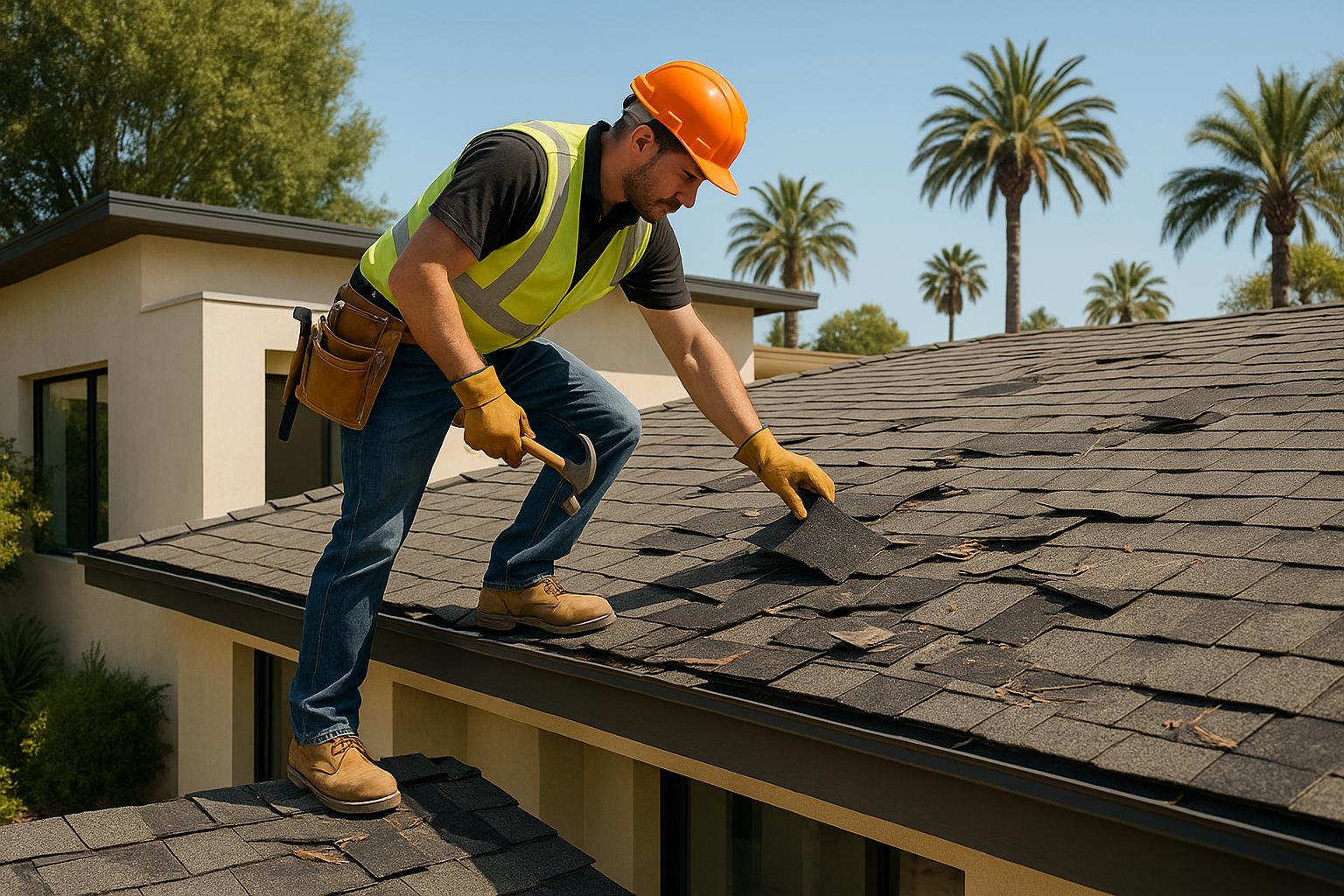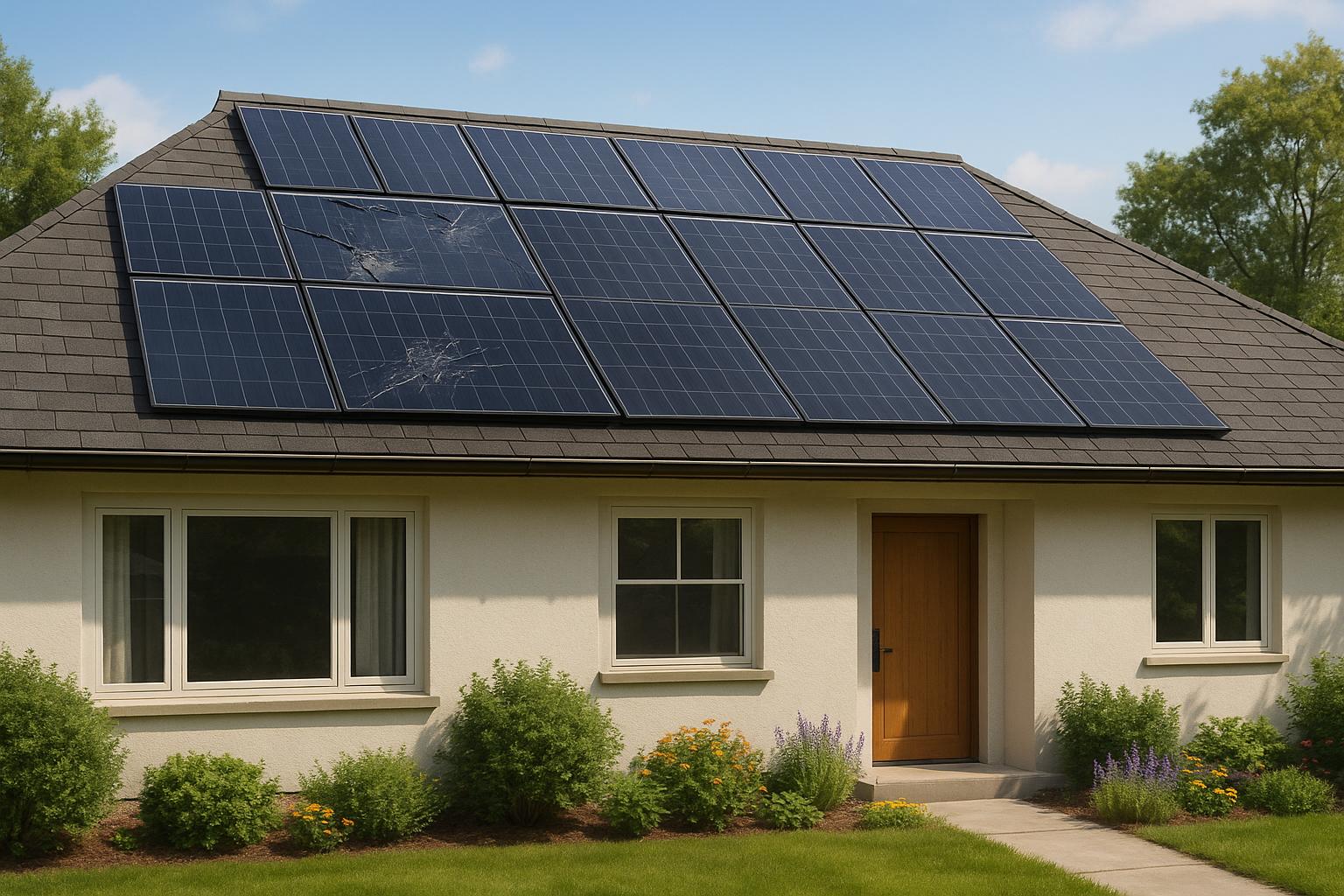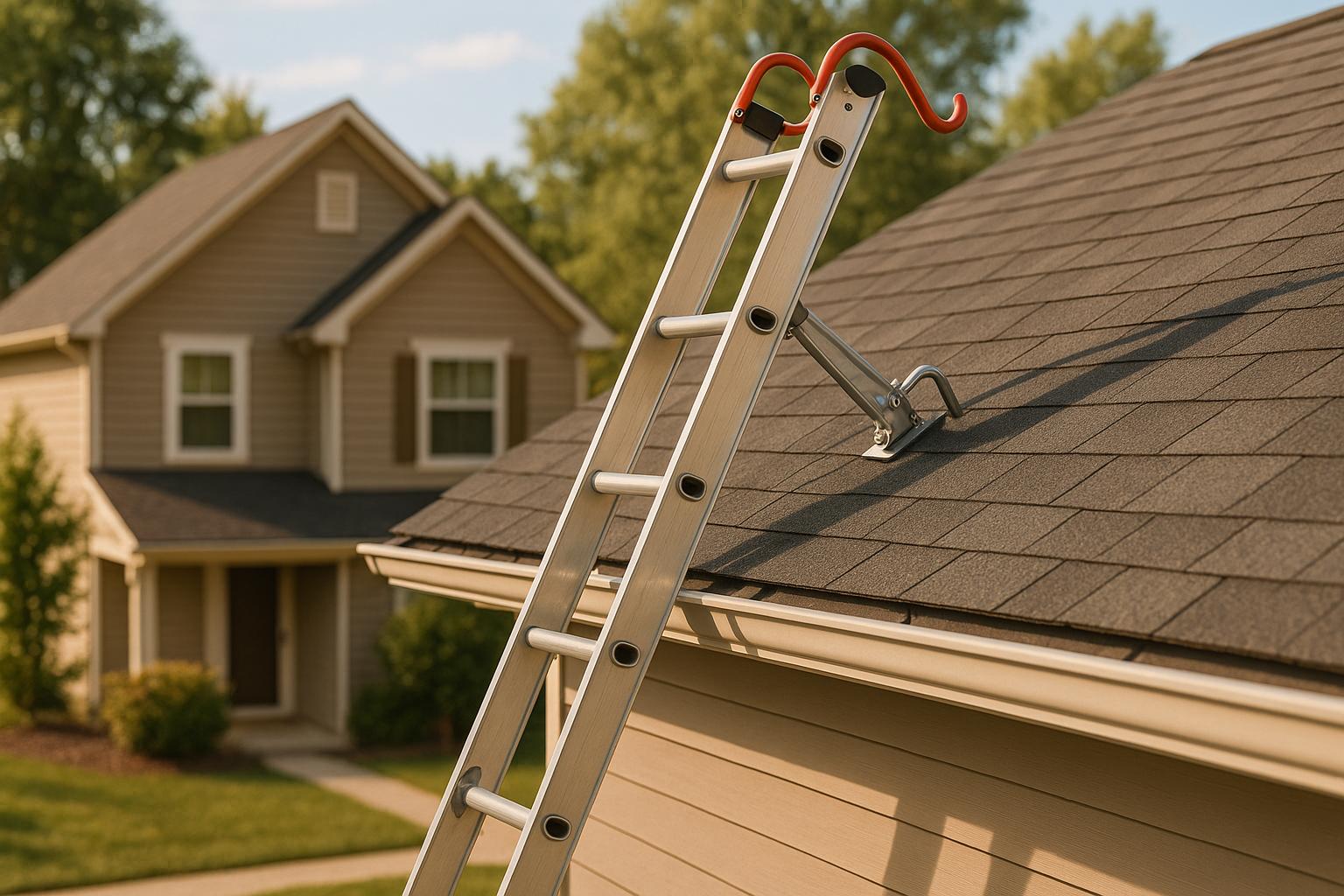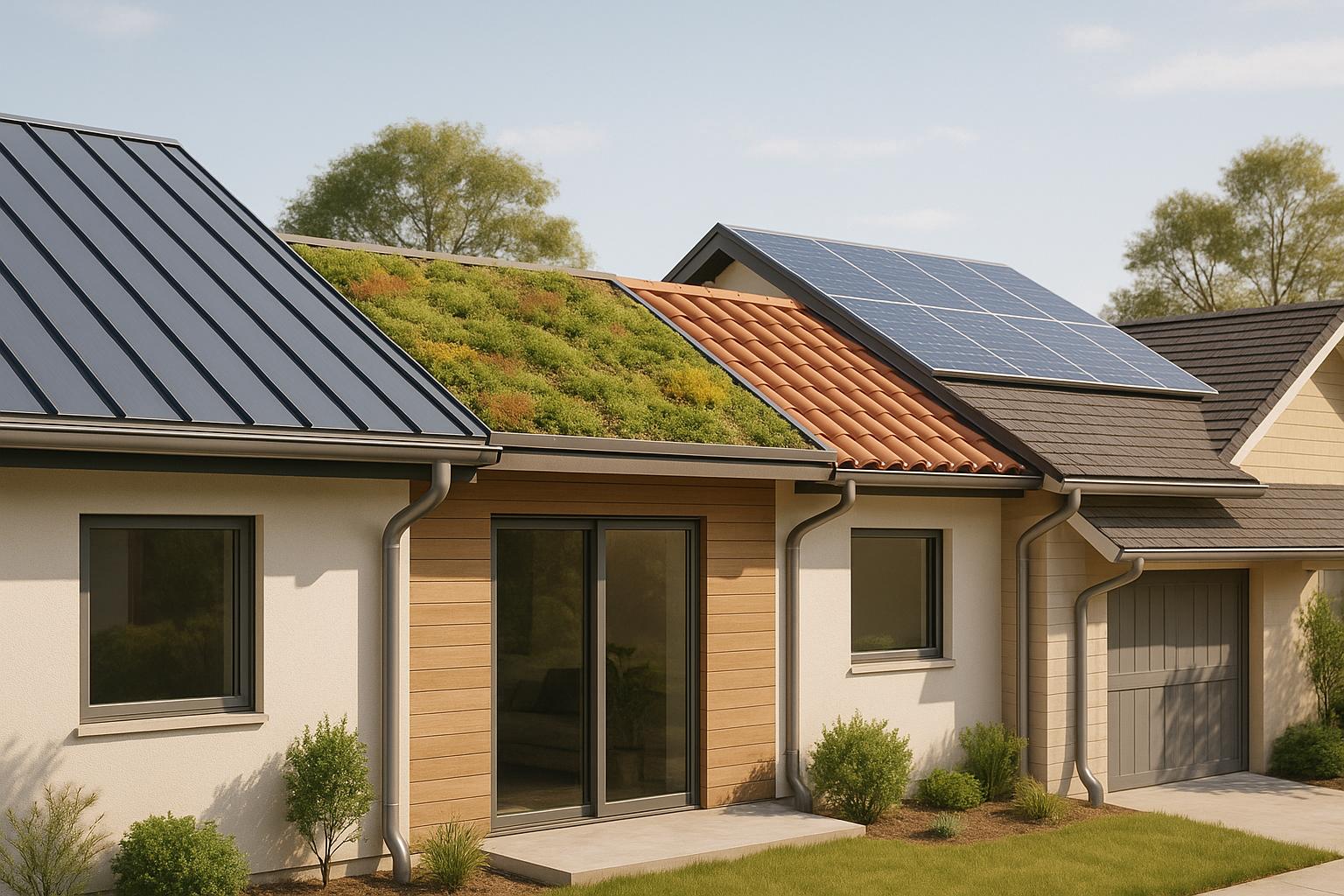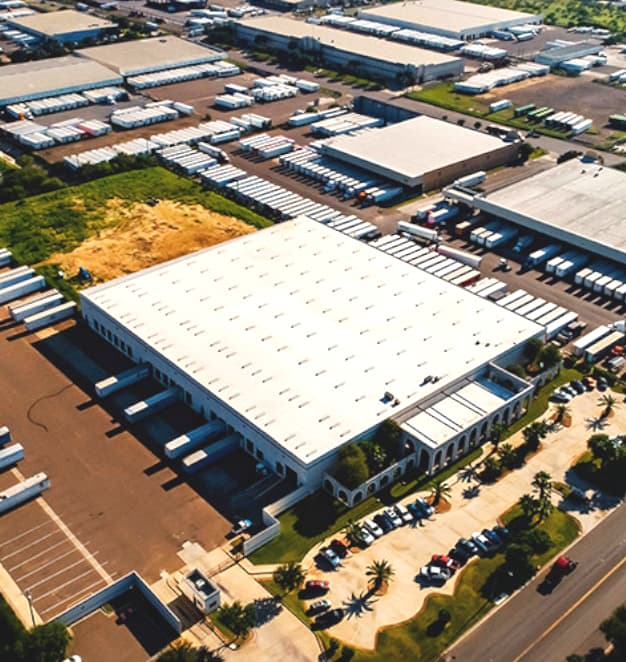Dealing with storm damage to your roof in Beverly Hills? Here’s what you need to know:
- Inspect Your Roof Safely
- Look for missing shingles, dents, or cracks.
- Check gutters for asphalt granules or dents.
- Inspect your attic for leaks, sagging, or mold.
- Temporary Fixes
- Use a tarp to cover damaged areas and prevent water intrusion.
- Clear debris carefully to avoid additional damage.
- Professional Help
- Call a roofing contractor for a thorough inspection and repairs.
- Prime American Roofing offers free inspections and specializes in Beverly Hills homes.
- File an Insurance Claim
- Document all damage with photos and notes.
- Review your policy and report damage within 24–72 hours.
- Future Protection
- Upgrade to weather-resistant materials like metal or stone-coated steel.
- Schedule regular roof inspections and maintenance.
Quick Tip: Address damage immediately to avoid costly repairs and keep your home safe.
How to Tell That You Have a Storm Damaged Roof (GUIDE)
How to Check Your Roof for Storm Damage
After a storm hits Beverly Hills, inspecting your roof is a must – but it’s essential to do so carefully and methodically. Here’s a step-by-step guide to help you check for damage while keeping safety a priority.
Safety First: Protect Yourself and Your Property
Never inspect your roof alone. Having someone with you is not only safer but can also provide an extra set of eyes to spot damage. Before climbing up, take a moment to assess the situation. If the roof’s slope seems too steep or if you feel uneasy about the climb, it’s better to call in a professional.
Weather matters, too. Avoid inspecting the roof when it’s wet, icy, or even damp from morning dew. Slippery surfaces can turn a simple inspection into a dangerous situation.
If you’re confident about climbing, make sure to use a sturdy ladder that extends at least three feet above the roofline. Place it on firm, level ground for stability. Wear shoes with good traction – smooth-bottomed or hard-soled footwear increases the risk of slipping. If climbing still feels unsafe, grab a pair of binoculars to inspect the roof from the ground.
Look for Common Signs of Damage
Start your inspection from the ground by walking around your home’s exterior. Look up at the roof and check for missing, lifted, or creased shingles – all clear signs of storm damage. Missing shingles are usually easy to spot, but lifted or creased ones might require closer observation.
Next, inspect your gutters and downspouts. Dents on downspouts higher than five feet often indicate hail or debris damage. Also, check for asphalt granules in the gutters or around the downspouts. These tiny, sand-like particles protect shingles from UV rays, and their presence in gutters suggests the shingles may be compromised.
Take a closer look at roof vents, flashing, and shingles for dents about 1 inch in diameter. Pay special attention to flashing around chimneys, vents, and skylights – cracked, rusted, or loose flashing can allow water to seep into your roof.
Don’t forget to inspect inside your home. Water stains or damp spots on ceilings or walls could point to roof leaks. Use a flashlight to check your attic for signs of trouble, such as leaks, dark spots, sagging wood, or even holes. A sagging roof structure might indicate serious water damage or weakened materials.
Finally, check for damage caused by trees. Tree limbs or even an entire tree hitting the roof can cause significant damage, even if it doesn’t look severe from the ground. If you’re unsure about the extent of the damage, it’s time to call in a professional.
When to Call a Professional Inspector
After your initial inspection, a professional assessment can confirm what you’ve found and identify hidden damage. If you notice structural issues, water intrusion, or anything beyond your expertise, it’s best to contact a roofing contractor immediately.
In the aftermath of severe storms, or if you spot significant damage, a professional inspection is highly recommended. These inspections typically take 1 to 2 hours. Contractors start by examining the ground for visible signs of damage and then move to the roof to check for missing or curled shingles, granule loss, and dents in flashing or vents. They’ll also look for pooling water, which could indicate drainage problems.
Prime American Roofing, for example, provides free inspections and has extensive experience assessing storm damage in Beverly Hills. Their team understands the area’s architectural nuances, making it easier to spot issues that might escape an untrained eye.
During the inspection, professionals often take photos and prepare detailed reports outlining their findings and suggested repairs. It’s a good idea to take your own photos and notes during your inspection – this documentation can be invaluable for insurance claims and when consulting with roofing contractors. Remember, what looks like minor damage on the surface could be hiding more serious problems that only an expert can properly evaluate.
Quick Fixes to Stop More Damage
When a storm hits your Beverly Hills roof, taking quick action can help prevent further water damage. Temporary solutions can protect your home until permanent repairs are in place.
How to Tarp and Secure Your Roof
One of the quickest ways to limit water intrusion after storm damage is by installing a temporary tarp. When done properly, a tarp can shield your roof from the elements for up to 90 days.
Safety tips to keep in mind:
- Avoid working during active storms or unsafe conditions.
- Wear protective gear like gloves, safety goggles, and sturdy boots.
- Use a properly secured ladder, with assistance if possible.
- Make sure the ladder extends at least three feet above the roofline.
Start by clearing debris from the damaged area, then measure the section you need to cover, adding 3–4 feet on all sides for overlap. For short-term fixes, secure the tarp with sandbags. For a longer-lasting solution, use 2×4 boards as anchors. If there are large holes, cover them with plywood first to provide a stable base and prevent the tarp from sagging into the gaps.
For anchor boards, cut 2×4 lumber and nail the tarp to the board. Then, screw the board into the roof decking to hold everything in place. Keep the tarp stretched tight to prevent water from pooling, which could strain both the tarp and your roof structure.
"Safety should be your top priority whenever it comes to roofing work. You should always avoid tarping your roof if it is unsafe to do so: because the damage is severe, the weather is getting worse, or you do not have the proper safety equipment to get the job done."
– Gouge Quality Roofing
Be sure to regularly inspect your tarp for tears, gaps, or loose edges, as the changing weather in Beverly Hills can quickly undermine your temporary fix. Once the tarp is secure, focus on clearing debris to further stabilize the area.
How to Remove Debris Safely
Cleaning up storm debris is just as important as securing your roof, but it requires careful handling to avoid injuries or additional damage. Always wear protective gear and avoid working in wet or windy conditions.
Sort debris into categories like leaves and branches, construction materials, and hazardous items to make disposal easier. Start by removing large debris by hand, taking care not to damage shingles or other roofing materials.
Use tools that won’t harm your roof for stubborn debris. For moss, gently pull it away and consider using a moss killer or bleach solution to prevent it from coming back. Don’t forget to clear gutters and drainage systems as part of your cleanup. Clogged gutters can lead to water pooling on the roof, which might cause even more damage.
For extensive debris – especially on steep roofs or areas with structural concerns – it’s best to bring in professionals.
"Clearing debris is about more than just improving curb appeal – it’s a proactive step to protect your home from damage and extend the life of your roofing system."
– GP Martini Roofing Co.
If you encounter electrical hazards, severe structural damage, or debris that’s too dangerous to handle, step back and call for expert help. Companies like Prime American Roofing can assess the situation and handle complex debris removal, ensuring your safety while protecting your roof.
Repair Options for Beverly Hills Roofs
When it comes to roof repairs in Beverly Hills, the method you choose should align with the specific material used on your home. The area’s diverse architectural styles mean a variety of roofing materials, each requiring a tailored approach. Here’s a closer look at how to handle repairs for some of the most common roof types.
How to Repair Different Roof Materials
Clay and Concrete Tiles are a staple of Spanish Colonial and Mediterranean-style homes in Beverly Hills. For these roofs, replace any cracked or broken tiles individually with matching pieces to maintain the aesthetic. For smaller cracks, high-quality sealants can often do the trick.
Asphalt Shingles, which typically last 20–25 years, can often be repaired by replacing individual damaged or missing shingles. However, if more than 30% of the roof has damage, a full replacement might be more cost-effective in the long run.
Metal Roofing Systems are prized for their durability, lasting 40–70 years. Repairs often involve precise techniques like welding or replacing damaged panels. Common issues include dents or loose fasteners caused by storms, both of which require expert attention.
Flat or Low-Slope Roofs, often seen on modern homes in the area, use membrane systems that can develop punctures or tears. Repairs typically involve patching the damaged sections or replacing parts of the membrane to ensure a watertight seal.
When deciding between repairs and a full replacement, consider the roof’s age and the extent of the damage. If your roof is over 15 years old and has significant issues, replacing it may be a smarter long-term investment. Companies like Prime American Roofing offer thorough assessments to help homeowners make informed decisions.
Repairs for Historic and Luxury Homes
Beverly Hills is home to many historic and luxury properties, and repairing these roofs requires a more specialized approach to balance preservation with functionality. These homes often feature unique architectural details, rare materials, and strict aesthetic standards, making standard repair methods insufficient.
For historic properties, the priority is preserving original materials. This involves sourcing authentic period materials and carefully documenting the process to maintain the home’s historical integrity. Modern tools, like heat-sensing cameras, can help identify hidden damage and provide insight into the roof’s original construction methods.
Matching materials is a meticulous process; new components must align perfectly in terms of composition, color, texture, and design. Additionally, Beverly Hills has specific historic preservation guidelines, so it’s essential to consult with preservation societies or historical organizations early in the project to ensure compliance.
While maintaining the historic appearance, modern upgrades can improve the roof’s performance. Hidden waterproofing, better insulation, or reinforced supports are examples of enhancements that can be integrated without compromising the home’s character.
For luxury homes without historic designation, the focus shifts to maintaining architectural integrity while potentially upgrading to superior materials. These properties often feature custom tile work, intricate color schemes, and unique architectural details that require the skill of experienced artisans. Regular maintenance is especially critical for these roofs to protect both their value and design.
Prime American Roofing collaborates with homeowners to create maintenance plans that safeguard the investment and preserve the architectural charm of these distinctive properties.
sbb-itb-d1d6490
How to File Insurance Claims for Roof Repairs
Once you’ve stabilized your roof and taken care of immediate repairs, the next step is filing your insurance claim. Navigating this process correctly is key to securing the coverage you’re entitled to. Most homeowners insurance policies cover roof damage caused by sudden events like hailstorms, strong winds, or falling debris. In California, insurers are required to settle or deny claims within 40 days after receiving proof of your claim.
Start by reviewing your policy to understand what’s covered. Then, arrange for a contractor and your insurance company to inspect the damage. Once your claim is approved, you’ll receive an initial payment, and repairs can be scheduled. Keep in mind that only the insurance adjuster has the authority to approve your claim. To strengthen your case, ensure you document the damage thoroughly. Here’s how to do it.
How to Document Damage for Insurance
Accurate documentation can make or break your claim. Start by inspecting the damage safely – stick to ground-level observations and leave climbing to professionals. Your goal is to create a detailed record that paints a clear picture of the damage.
- Take wide-angle photos of your roof and its surroundings to capture the overall scope.
- Focus on specific areas with close-up images of damaged shingles, broken tiles, cracks, or blistering.
- Highlight weather-related damage: Photograph dents from hail, missing shingles caused by wind, and any standing water or signs of leaks.
- Don’t forget key features like chimneys, vents, skylights, and flashing. Look for signs of displacement or damage.
Include both exterior and interior damage in your records. For instance, document water stains, leaks, or mold inside your home. Use time-stamped photos and videos to establish a clear timeline of events. If you have older photos of your roof, include those as well to show the difference before and after the damage.
In addition to visual evidence, keep a written log. Note the date and time you discovered the damage, describe each issue in detail, and record conversations with contractors or insurance representatives. Thorough documentation is your best defense against claim delays or denials.
Beverly Hills Insurance Rules and Deadlines
Homeowners in Beverly Hills face specific insurance guidelines that can impact how claims are processed. Most policies require you to report damage quickly – usually within 24 to 72 hours of discovering it. Failing to meet this deadline could result in your claim being denied.
Insurance companies in Southern California are also becoming stricter about residential roofing. Roofs that are 15–20 years old, even without visible leaks, may raise red flags. Materials like 3-tab shingles or wood shake are often classified as outdated. If your policy renewal depends on replacing an aging roof, acting promptly is crucial.
Understanding your policy is just as important. Most homeowners have either "named peril" coverage, which only covers specific risks listed in the policy, or "open peril" coverage, which covers everything except explicitly excluded damages. Be aware of common exclusions like flood, earthquake, mold, routine wear and tear, or pest damage. If these risks are common in your area, consider adding extra coverage through endorsements or riders.
Throughout the process, work closely with your insurance adjuster. They can deny claims if the damage appears to result from neglect or issues not covered by your policy. Professional documentation, like detailed repair estimates from Prime American Roofing, can provide expert support for your claim.
Once your documentation is submitted and the adjuster completes their review, you’ll typically receive an initial payment to start repairs. By understanding these Beverly Hills-specific rules and timelines, you can help ensure your claim is processed efficiently and without unnecessary setbacks.
How to Protect Your Roof from Future Storms
Once your roof has been repaired, it’s time to think ahead. Taking steps to protect your roof from future storms can save you money and stress down the line. This means upgrading materials, scheduling regular inspections, and incorporating energy-efficient features. These proactive measures ensure your roof performs well for years to come.
Upgrade to Stronger, Weather-Resistant Materials
Modern roofing materials are designed to handle harsh weather conditions far better than older options. Take metal roofing, for example. It’s incredibly durable, with a lifespan of 40–70 years, and can withstand winds up to 140 mph. Plus, it’s resistant to hail damage and requires little maintenance compared to traditional asphalt shingles.
"Metal roofs are designed to withstand severe weather, including hail, high winds, and heavy snow. They are far more resistant to damage than traditional asphalt shingles." – SRS Roofing
Another excellent choice is stone-coated steel roofing, which combines strength with style. DECRA roofing systems, for instance, are designed to handle hailstones up to 2.5 inches in diameter and are rated Class 4 for impact resistance by Underwriters Laboratories.
"Warrantied for winds up to 120 miles per hour and rigorously tested to meet the TAS-100 wind-driven rain standard, every DECRA product is approved for use in High-Velocity Hurricane Zones (HVHZ)." – DECRA Metal Roofing
If you prefer more traditional options, slate roofing offers wind resistance up to 110 mph and is also fire-resistant. Clay tiles are another solid option for windy environments. Whatever material you choose, make sure it’s Class A fire-rated for maximum protection. It’s also worth checking your homeowner’s insurance policy to see if it covers cosmetic damage for metal roofs.
Schedule Regular Roof Maintenance and Inspections
Keeping up with regular roof inspections is one of the simplest ways to prevent damage. Aim for professional inspections twice a year and after severe weather events. This is especially important for roofs older than 15 years, as aging materials are more prone to storm damage. Plus, many roofing warranties require regular inspections to stay valid, so don’t skip them.
During an inspection, professionals look for issues like cracked or missing shingles, rust or corrosion on metal parts, leaks, moisture damage, compromised flashing, clogged gutters, and poor attic ventilation. Local roofing experts can pinpoint weak spots before they become major problems. Between inspections, you can help maintain your roof by clearing debris, trimming overhanging branches, and checking for damage after storms. This routine care can help asphalt shingle roofs last their full 20–30 years and keep metal roofs in top condition for decades.
Adding energy-efficient features to your roof can further enhance its durability and performance.
Add Energy-Efficient Features
Energy-efficient upgrades not only protect your roof but also lower energy costs. Reflective roof coatings, for instance, can reduce roof surface temperatures by up to 30% and extend the roof’s lifespan by 25–30 years. These coatings create a seamless, waterproof barrier that protects against water damage while reflecting sunlight.
"Roof coating is a liquid-applied material that forms a seamless, waterproof, and reflective layer over your existing roof… helping seal cracks, prevent water damage, and reflect sunlight, keeping your property cooler and reducing energy costs." – GreenGo Roofing
Different coatings work best for specific conditions: acrylic coatings are ideal for low-sloped roofs in dry climates, while silicone coatings are better for flat roofs in areas with frequent rain. If you’re considering solar panels, modern techniques allow coatings to be applied around the panels without needing costly removal. Companies like Prime American Roofing specialize in integrating solar panels in a way that strengthens your roof.
Another option is cool roof systems, which reflect 60–90% of sunlight with white roofs or 30–60% with "cool colored" roofs. These systems can combat urban heat island effects and reduce heat buildup. Proper roof ventilation also plays a key role by preventing the heat accumulation that can weaken roofing materials. When combined with impact-resistant shingles, these features provide a strong defense against storms, while potentially lowering your energy bills and even your insurance premiums.
Conclusion: Keep Your Roof Strong and Storm-Ready
Taking the right steps after a storm can make all the difference in keeping your roof safe and secure. Quick action is essential – start by assessing the damage, applying temporary fixes to protect your home, choosing proper repair materials, and documenting everything for your insurance claim.
Did you know that wind and hail cause 34% of homeowners’ insurance claims? Delaying repairs can lead to bigger problems like water damage, mold growth, and skyrocketing costs. To avoid these issues, make roof maintenance a priority. Schedule annual inspections, clean your gutters twice a year, and trim any branches hanging too close to your roof. For extra peace of mind, consider upgrading to storm-resistant roofing materials, which can handle winds over 130 mph.
Prime American Roofing has been serving Beverly Hills for decades, offering everything from emergency repairs to preventive upgrades. They provide free inspections, help with detailed insurance documentation, and use durable materials to ensure your roof is built to last. Trust Prime American Roofing to protect your home and your investment for years to come.
FAQs
What steps should I take right after discovering storm damage to my roof in Beverly Hills?
What to Do After Storm Damage to Your Roof
Your safety comes first after discovering storm damage to your roof. Start by inspecting your surroundings for potential hazards like loose debris, exposed wires, or structural issues. Only proceed when you’re sure it’s safe. Once clear, grab your phone or camera and document the damage with plenty of photos and videos – these will be crucial for filing an insurance claim.
If you can, take steps to make temporary repairs to prevent things from getting worse. For example, you could use a tarp to cover exposed areas and shield your home from additional damage. Afterward, notify your insurance company to report the damage and begin the claims process.
Finally, get in touch with a reliable roofing professional for a thorough inspection and permanent repairs. Their expertise will ensure your roof is fixed properly and your home is secure again.
What’s the best way to document roof damage for an insurance claim?
To properly document roof damage for an insurance claim, start by assessing the situation safely. If possible, use binoculars or examine the roof from the ground to identify issues like missing shingles, dents, or sagging sections. For extensive damage, it’s wise to bring in a professional for a detailed inspection.
Take clear photos and videos to support your claim. Capture wide-angle shots of the entire roof, along with close-ups of specific damage, such as cracked shingles or holes. Don’t forget to document any debris, like fallen branches, that may have caused the damage. Alongside visual evidence, maintain a written record that includes the date, time, and details of the incident – such as the type of storm and its effects. This thorough approach can help make the insurance claim process smoother and reduce potential delays.
What are the best roofing materials to protect my home from storm damage in Beverly Hills?
To protect your home in Beverly Hills from storm damage, it’s worth considering metal roofing, concrete tiles, or impact-resistant shingles. These materials are built to handle tough weather and provide reliable protection.
Metal roofs are incredibly durable, standing up to winds as strong as 140 mph and even hail. Plus, they last for decades, making them a solid choice for areas prone to severe storms. If you’re looking for something stylish yet sturdy, concrete tiles fit the bill. They not only offer a sleek, modern appearance but also hold up well against heavy rain and hail. Meanwhile, impact-resistant shingles are engineered to withstand hits from hail and flying debris, giving your home extra defense without sacrificing curb appeal.
Switching to these roofing materials can give you peace of mind, knowing your roof is built to handle Southern California’s unpredictable weather.

